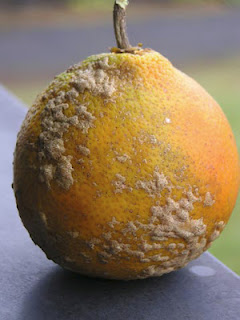The
yellow passionfruit, Passiflora edulis f. flavicarpa, and the
purple passionfruit, Passiflora edulis, are grown in most tropical and
subtropical parts of the world. The yellow passionfruit is a tropical plant
while the purple is considered subtropical, being able to survive some freezing
temperatures.
Of
the hundreds of species in the genus Passiflora, these two, P.
edulis, and P. edulis f. flavicarpa, are solely designated as
passionfruit. In Hawaiian, the fruit is
called lilikoi and in Portuguese, maracuja peroba. When the seeds of purple passionfruit first came to Hawai`i from Australia in 1880,
they were planted in East Maui in the District of Lilikoi and that name stayed
with the fruit. The seeds of the yellow
passionfruit were brought to Hawai`i from Australia in 1923.
In 1951, there were only a few acres of
passionfruit plantings. It was then that the University of Hawai`i chose
passionfruit as the most promising crop for development. And by 1958, there
were 1,200 acres of primarily yellow passionfruit, and the industry was firmly
established.
The
lilikoi vine is a shallow rooted perennial, displaying beautiful, fragrant
flowers, 2-3 inches wide. The fruit is nearly round approximately 1 ½ - 3
inches wide. Inside, the fruit is filled
with an aromatic mass of juicy pulp and within are as many as 250 small, edible
seeds. These vines, especially the
yellow, are fast-growing and will begin to bear in 1 to 3 years. In fact, some
vines can flower and fruit within a year after being started from seed. In
Hawai`i, passionfruit matures from June through January; the ripe fruit will
fall to the ground.
Carpenter
bees are efficient pollinators for the yellow passionfruit. Honey bees and the
hover fly also help in pollinating but are much less efficient. Wind is
ineffective as a pollinator because of the heaviness and stickiness of the
pollen.
The
yellow lilikoi vine tends to be more vigorous and the fruit generally larger
than the purple. While the purple appears to grow better at higher elevations,
400 to 3,000 feet, the yellow fruit is best adapted to lower elevations, from
sea level to 1,500 feet. Furthermore, the yellow will yield 3 to 4 times that
of the purple, yet the purple fruit is considered to have better flavor and aroma
with the pulp being less acid with a higher proportion of juice.
Passionfruit
vines are usually grown from seeds. If
the seeds are planted soon after being removed from mature fruit, most will
germinate in 2 to 3 weeks. Fortunately, seeds do not require cleaning, drying
or storage. They can be planted immediately after being removed from the fruit,
even separation from the pulp is not necessary. In fact, allowing the pulp to
ferment for a few days may hasten germination. In contrast, seeds that have
been cleaned and stored actually have a lower and slower rate of
germination.
Propagation of passionfruit
can also be accomplished through air layering and cuttings. Good soil drainage
is essential for successful plantings.
Commercially,
vines are trained on wire trellises. For backyard production, however, the
yellow passionfruit is more productive and less subject to pests and diseases
if allowed to climb a tall tree.
In
Hawai`i, Oriental and melon fruitflies will deposit eggs in young fruit. This
may cause fruit to shrivel and fall from the vine. If older fruit is pierced,
the only ill effects will be an external scar. Other pests include aphids,
scale, thrips and mites. In spite of all these, passionfruit or lillikoi vines
flourish on fences and in trees, in backyards and vacant lots around the
Islands.
The
juice with its distinct flavor and aromatic bouquet is a key ingredient in
making sauce, candy, ice cream, sherbet,
iced tea, or in cocktails. In the
Hawaiian Islands lillikoi is a favorite flavor enjoyed by young and old alike.
Photos by Forest and Kim Starr







.jpg)




